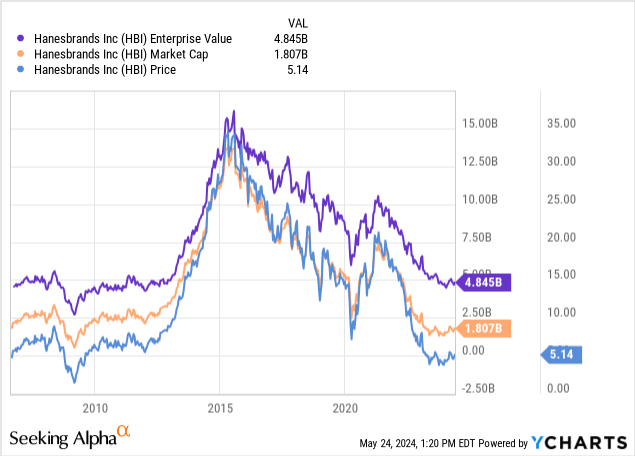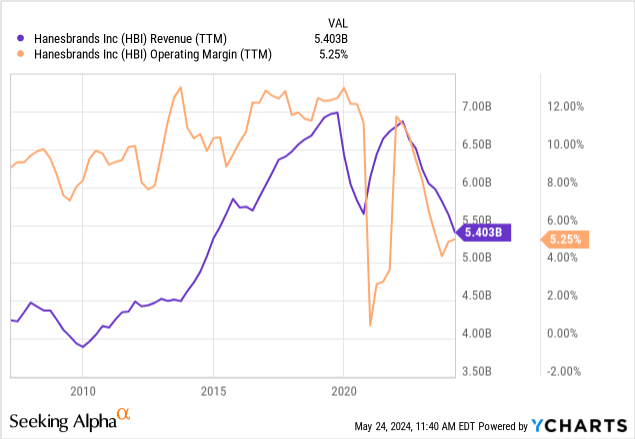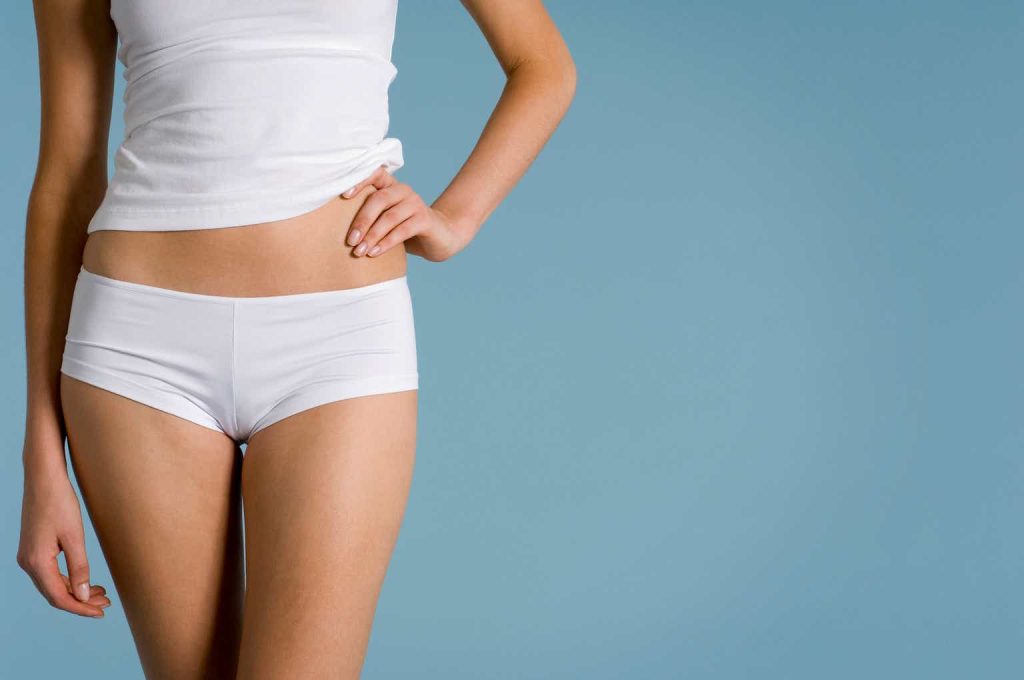Hanesbrands (NYSE:HBI) is an apparel manufacturer. The company owns Hanes, Champion, and other brands.
In early April 2024, I published an initiation coverage article on Hanesbrands with a Hold rating. The rating was based on the company’s valuation, considering different turnaround scenarios and two potential valuations for the Champion brand, which the company is considering selling.
I review the company’s 1Q24 results and earnings call in this article. I find a continued recovery of profitability from the cost side, offset by revenue weakness in all of the company’s segments. Management did not provide updates on Champion’s potential sale, and rumors continue about possible deal prices.
The company’s stock price has not changed much, but I have updated my valuation with a more detailed review of Champion’s profitability. Overall, I think the stock is still a Hold and not an opportunity based on its valuation.
1Q24 profit recovery and revenue challenges
Sales headwinds: All Hanesbrands segments posted negative topline results in 1Q24. Champion revenues were particularly negative, at 25% YoY (negative 20% when adjusted for the licensing of the Kids business).
Champion has faced problems since 2021. FY23 revenues for the Activewear segment, which is mainly comprised of Champion’s revenues, were down 25% compared to the FY21 peak.
The innerwear segment, which comprises the Hanes brand in the US, was down 8%, challenged in the wholesale channel. This seems to be more of a market-wide dynamic, as other innerwear-heavy companies like Gildan (GIL) showed similar results in their recent call.
The international segment, which mixes both Activewear (mostly Champion) and Innerwear sales in foreign countries, was down 9%, on a mix of reasons arising from Champion’s problems and the innerwear market’s weakness.
Profitability is recovering fast: Margins for the company came much better than one year ago. At the aggregate level, despite the revenue decrease, HBI’s gross margins were 770 basis points higher than a year ago. The bulk of the recovery came from cost decreases, particularly in cotton and freight. Again, the situation is similar to Gildan’s.
The results are even better than reported when we adjust for two factors: restructuring and higher marketing investment. HBI’s unadjusted operating margin was about 4.5%, not too different from 1Q23 levels. However, the result included $32 million in restructuring charges ($17 million from the search for a buyer for Champion). If we add back these non-recurring costs, the business’s operational margin is closer to 7.2% for the quarter.
In addition, the company increased advertising expenses by 1.8% of revenues compared to one year ago. Marketing can be considered a form of discretionary investment expensed today but enjoyed in future quarters. If we adjust for this change, the operating margin gets closer to 9%.
FY24 guidance reaffirmed: The company also reaffirmed its confidence in achieving FY24 guidance of revenues of about $5.4 billion (down 4% from FY23) and operating income of about $430 million (margin of about 8%).
No comments on Champion sale: The company did not mention any updates on the potential sale of Champion. When an analyst explicitly asked during the call, management reaffirmed that there is external interest in the brand but that the company is considering whether or not to sell it. In a recent development, rumors were published about Authentic Brands having exclusivity on the deal but offering a price of $1 billion, which is considered low by HBI’s management. This has not been confirmed by the company.
Sharpening the pencil on Champion’s sales
HBI’s stock price has not changed much since my last article, and the company is operating according to guidance. In April, the potential sale of Champion to Authentic Brands at a price between $1 and $1.5 billion was already on the table. Therefore, the main conclusions of the valuation from that article are still valid.
However, in this article, I wanted to explore the potential effect of Champion’s sale on the revenues of the International segment. Hanesbrands does not release standalone Champion revenues, which are mixed in the Activewear and International revenues.
I believe most of the Activewear segment’s sales can be attributed to Champion. The reason is that the company does not own any other important brand in this segment, according to its latest 10-K. The International segment is more difficult because Hanesbrands can sell Hanes innerwear abroad, and also owns a leading innerwear company in Australia called Bonds.
If we only considered Activewear sales as the loss from a sale of Champion, we would be overestimating the post-sale revenue potential of the company.
The only reference I could find on Champion’s global sales was the company’s 2021 Investor Day. At the time, management mentioned that Champion would grow 50% between 2022 and 2024 to reach $3 billion in global sales. This means the brand was selling about $2 billion in FY21.
However, FY21 also showed the company’s peak sales. Activewear sales have fallen 25% since. Therefore, I believe Champion’s global sales are probably closer to $1.5 billion now.
Revisiting the valuation
Now, we can revisit the valuation using the adjusted Champion figures. Hanesbrands trades for a market cap of $1.8 billion and an EV of $4.85 billion.

First, we can think of Hanesbrands without selling Champions. Management’s guidance is a good starting point for a neutral scenario valuation. That would represent revenues of $5.4 billion and an adjusted operating income of $430 million, or a margin of 8%. The margin is consistent with the post-adjustments margin for 1Q24.

Using a 25% income tax rate on that operating income, we arrive at a NOPAT of $322 million. Compared to an EV of $4.85 billion, this results in an EV/NOPAT multiple of 15x. I believe this multiple is excessive for a company that is challenged, leveraged, and operates in a cyclical industry like apparel. A more reasonable multiple, in my opinion, is 10x or lower. This is not based on the company’s previous multiples or the multiples applied to peers but on what I consider a sufficient return on the investment. Given the long-term average market return is about 8% (a 12x multiple), we need a lower multiple to justify the risk of owning a challenged, leveraged company in a competitive industry.
If we move down the income statement, we have to remove interest. HBI’s TTM interest expense is $266 million, but after adjusting for debt repayments of $300 million announced for FY24, the interest expense will probably be close to $230 million. In this case, we come to a pre-tax income of $200 million and a net income of $150 million. Compared to a market cap of $1.8 billion, we arrive at a P/E ratio of 12x. More reasonable, but still not opportunistic.
Then, we can consider a potential sale of Champion. The rumored offer from Authentic Brands is for $1 billion, but Hanesbrands supposedly is asking for more. Whatever is agreed on will have a portion eaten by investment bankers and taxes. We can, therefore, work with a $1 billion net proceeds assumption, which I believe is optimistic but will suffice.
From an EV perspective, the EV has decreased by $1 billion to $3.85 billion. Revenues would decrease by $1.5 billion under my previous assumptions. Operating income would decrease by $120 million if we apply the same 8% margin to Champion’s sales. The Innerwear segment has historically presented a higher margin than Champion’s, so I think this assumption is safe.
In that case, we would have an EV of $3.85 billion, an operating income of $310 million, and an NOPAT of $232 million. The resulting EV/NOPAT multiple would be 16.5x, excessive in my opinion, as explained above.
If we move down the income statement, the $1 billion can be used to pay the company’s highest-yielding debt at 9% (this was the implied course of action mentioned by management in the 1Q24 call). This would decrease interest expense by $90 million on top of the $30 million lower from debt repayments already guided for. The final interest bill would come to $140 million.
Removing $140 million in interest and 25% taxes from $310 million in operating income results in about $130 million in net income. Again, compared to a current market cap of $1.8 billion, it results in a P/E ratio of 13.8x, even higher than without selling Champion.
I believe these multiples are excessive for Hanesbrands. Again, the company is challenged, has not managed its brands correctly, is leveraged (and will continue to be leveraged even after a potential Champion sale), and operates in a cyclical industry like apparel. A more reasonable multiple, in my opinion, is 10x or lower. This is not based on the company’s previous multiples or the multiples applied to peers but on what I consider a sufficient return on the investment.
For that reason, I believe Hanesbrands is still a Hold.
Upside risks
I believe there are three potential upside risks to my thesis.
The first one is that Hanesbrands sells Champion at a higher price. This would reduce debt or EV by a higher amount than forecasted, potentially offering more upside. However, considering the offers that have been rumored, I believe this is unlikely.
The second risk is that Champion’s sales and profits are lower than forecasted, and therefore, post-sale, HanesBrands’ profits are higher than predicted. This could happen because the company does not reveal brand-specific figures.
Finally, Hanesbrands could turn the Champion ship around, improving the guided figures and making the brand more valuable for a potential acquirer. The recent increase in marketing, on top of previous restructuring measures like reducing SKUs and licensing adjacent businesses, is a move in the right direction to recover the brand.
Read the full article here












